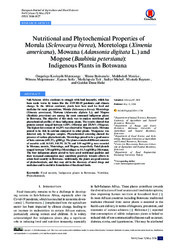| dc.contributor.author | Matenanga, Ompelege Keolopile | |
| dc.contributor.author | Boitumelo, Wame | |
| dc.contributor.author | Mareko, Molebeledi | |
| dc.contributor.author | Mojeremane, Witness | |
| dc.contributor.author | Seifu, Eyassu | |
| dc.contributor.author | Tait, Motlalepula | |
| dc.contributor.author | Michel, Sadiye | |
| dc.contributor.author | Bayram, Mustafa | |
| dc.contributor.author | Haki, Gulelat Desse | |
| dc.date.accessioned | 2024-05-15T09:03:25Z | |
| dc.date.available | 2024-05-15T09:03:25Z | |
| dc.date.issued | 2024-05-10 | |
| dc.identifier.citation | Matenanga, O. K., Boitumelo, W., Mareko, M., Mojeremane, W., Seifu, E., Tait, M., ... & Haki, G. D. (2024). Nutritional and Phytochemical Properties of Morula (Sclerocarya birrea), Moretologa (Ximenia americana), Mowana (Adansonia digitata L.) and Mogose (Bauhinia petersiana): Indigenous Plants in Botswana. European Journal of Agriculture and Food Sciences, 6(3), 16-21. | en_US |
| dc.identifier.issn | 2684-1827 | |
| dc.identifier.uri | https://www.ejfood.org/index.php/ejfood/article/view/780 | |
| dc.identifier.uri | https://hdl.handle.net/13049/736 | |
| dc.description.abstract | Sub-Saharan Africa continues to struggle with food insecurity, which has been made worse by issues like the COVID-19 pandemic and climate change. In the African continent, plants have been used for food and medicine for many generations. Morula (Sclerocarya birrea), Moretologa (Ximenia americana), Mowana (Adansonia digitata L.), and Mogose (Bauhinia petersiana) are among the most consumed indigenous plants in Botswana. The objective of this study was to analyse nutritional and phytochemical profiles of these indigenous plants. The results showed that protein content ranged between 1.80% (Morula) and 25.54% (Mogose). The highest fat content of 14.29% was observed in Mogose seeds. Mowana proved to be rich in calcium compared to other plants. Manganese was detected only in Mogose samples. Phytochemical screening showed the presence of various phytochemicals. Moretologa proved to be a good source of beta carotene (419.33 μg/100 g). The plants contained different amounts of ascorbic acid; 163.83, 141.59, 24.78, and 3.00 mg/100 g were recorded in Mowana, morula, Moretologa, and Mogose, respectively. Total phenols ranged between 7.98 mg/100 g (Moretologa) to 14.3 mg/100 g (Mowana). The four indigenous plants proved to have good nutritional qualities and their increased consumption may contribute positively towards efforts to attain food security in Botswana. Additionally, the plants are good sources of phytochemicals, and they may aid in the discovery of novel drugs and medicines and be useful in formulation of functional foods. | en_US |
| dc.language.iso | en | en_US |
| dc.publisher | European Journal of Agriculture and Food Sciences | en_US |
| dc.relation.ispartofseries | European Journal of Agriculture and Food Sciences;Vol. 6 (3): 2024 | |
| dc.subject | Food security | en_US |
| dc.subject | Indigenous plants in Botswana | en_US |
| dc.subject | Nutrition | en_US |
| dc.subject | Phytochemicals | en_US |
| dc.title | Nutritional and Phytochemical Properties of Morula (Sclerocarya birrea), Moretologa (Ximenia americana), Mowana (Adansonia digitata L.) and Mogose (Bauhinia petersiana): Indigenous Plants in Botswana | en_US |
| dc.type | Article | en_US |

